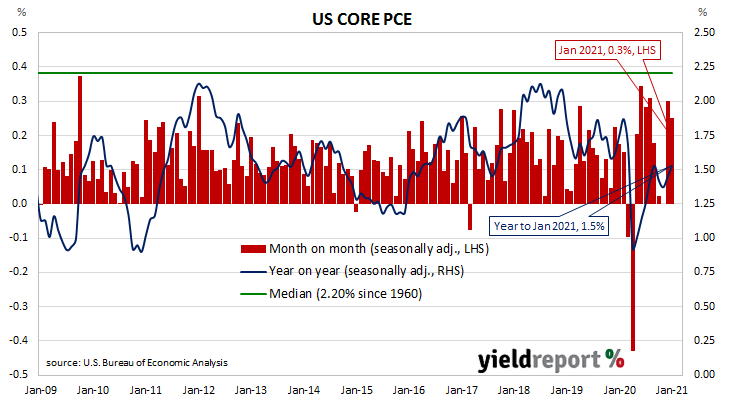Summary: US Fed’s favoured inflation measure up by 0.3% in January; above market expectations; annual rate ticks up after revisions; Treasury bond yields fall back following previous day’s spike.
One of the US Fed’s favoured measures of inflation is the change in the core personal consumption expenditures (PCE) price index. After hitting the Fed’s target at the time of 2.0% in mid-2018, the annual rate then hovered in a range between 1.8% and 2.0% before it eased back to a range between 1.5% and 1.8% through 2019. It then plummeted below 1.0% in April 2020 before rising in through the remainder of 2020.
The latest figures have now been published by the Bureau of Economic Analysis as part of the January personal income and expenditures report. Core PCE prices rose by 0.3% over the month, more than the 0.1% which had been generally expected but in line with December’s 0.3% increase after rounding. On a 12-month basis, the core PCE inflation rate ticked up from December’s revised rate of 1.4% to 1.5%.
ANZ economist Hayden Dimes said December’s fiscal package had produced a 2.4% rise in personal spending which fed into higher prices. “The spending on goods was broad-based and its strength showed in the PCE deflator data, with the 3-month annualised rate of change rising to 2.4%.

US Treasury bond yields fell back markedly after spiking on Thursday. By the close of business, the 2-year Treasury bond yield had lost 5bps to 0.12%, the 10-year yield had fallen by 9bps to 1.44% while the 30-year yield finished 16bps lower at 2.14%.
“With base effects due to push annual inflation higher in coming months, the data will feed questions about Fed patience, despite the Fed expecting any lift in prices to be transitory,” said Dimes.
The core version of PCE strips out energy and food components, which are volatile from month to month, in an attempt to identify the prevailing trend. It’s not the only measure of inflation used by the Fed; it also tracks the Consumer Price Index (CPI) and the Producer Price Index (PPI) from the Department of Labor. However, it is the one measure which is most often referred to in FOMC minutes.

